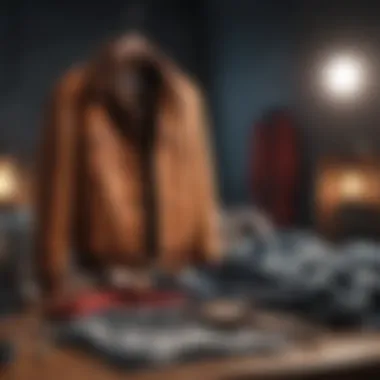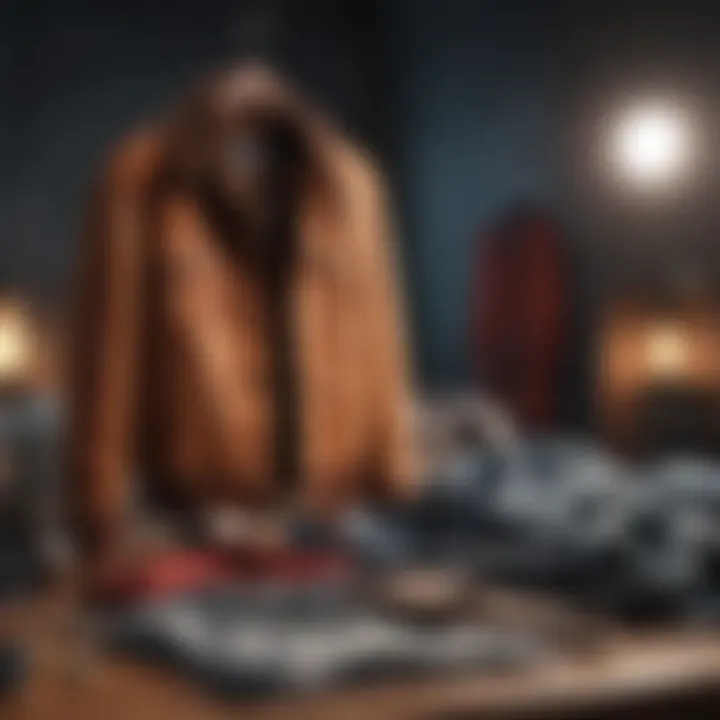Smart Strategies for Selling Unwanted Clothes


Overview of the Topic
Selling unwanted clothes can feel like a daunting task, but it holds significant value. Unlike just tossing items into the donation bin, strategically selling these garments brings both financial rewards and environmental benefits. When people declutter their wardrobes, they step into a larger conversation about sustainability in the fashion industry. With fast fashion's adverse effects glaring in recent years, shifting to second-hand sales offers an eco-friendly alternative.
The key benefits of selling unwanted clothing extend far beyond pocketing a bit of cash. First and foremost, it promotes conscious consumption. By reselling, individuals minimize waste and extend the lifecycle of their garments, preventing unnecessary landfill overflow. Moreover, it fosters a greater awareness of one's buying habits, as people begin to recognize the value of their possessions and the stories behind them.
Exploring Strategies and Tips
When it comes to selling clothes, a few practical approaches can place sellers ahead of the game. Here are some essential tips for a smoother implementation:
- Sort and Select: Start by categorizing your wardrobe. Focus on items in good condition, free from stains and damage. A simple rule is if you haven’t worn it in a year, then it’s time to rethink its place in your closet.
- Clean and Present: Presentation matters; ensure all garments are clean and pressed. A wrinkled, dusty shirt won’t attract buyers, so upfront effort can lead to better offers.
- Photography: Good photos go a long way. Use natural light and showcase the item from multiple angles. It's also helpful to include close-ups of any tags or detailing.
- Descriptive Titles and Details: Write clear, enticing descriptions. Mention brand names, sizes, and material composition. Include any unique features or styling tips.
- Choose the Right Platform: Different platforms cater to different audiences. For instance, Poshmark and Depop appeal to trend-focused buyers, while eBay may attract deal-seekers. Consider which aligns with your items to better reach potential buyers.
To manage the selling process effectively:
- Respond Promptly: Quick engagement can make the difference between a sale and a missed opportunity. Always answer questions or negotiate offers in a timely manner.
- Be Mindful of Pricing: Research similar items to understand price ranges. Setting a fair price is crucial; you want to attract buyers but still acknowledge the value of your clothing.
Case Studies and Examples
Let’s consider some real-life examples that highlight both successes and potential pitfalls in selling unwanted clothes.
One thriving user on Poshmark made a small fortune from her vintage collection. Initially, she invested time in learning about the site, its algorithms, and customer engagement. Her success came from consistently posting high-quality images and active participation in the community, often attending local meet-ups organized by Poshmark. This proved that involvement goes hand in hand with visibility.
Conversely, a seller on eBay faced challenges due to poor communication. Items were frequently listed without appropriate descriptions or clear images. As a result, the seller received minimal interest, leading to frustration. The lesson here is not to underestimate the details—proper communication can make or break your selling experience.
Expert Insights and Recommendations
Engaging in discussions with fashion experts provides valuable insights. Many underline the significance of storytelling; every piece has a narrative, whether it’s how it was acquired or memorable moments associated with it. Capturing this in your description can turn a mundane listing into an enticing opportunity for buyers.
Furthermore, experts suggest leveraging social media platforms like Instagram or Facebook to create buzz around your sale. You might post stories or reels showcasing your clothes, allowing friends and potential buyers to interact directly with the items. This adds a personal touch and often motivates shares, potentially expanding reach.
"Fashion is about more than clothing; it's about community and connection. Selling doesn’t have to feel transactional; turn it into a dialogue and experience."
Preamble to Selling Unwanted Clothes
The act of selling unwanted clothes isn't just a trendy practice; it serves a purpose that resonates across personal and financial realms. In a world where fast fashion has made it all too easy to accumulate garments that rarely see the light of day, the importance of tidyining up one's wardrobe cannot be overstated. Getting rid of unused apparel is more than a clearing exercise—it's a crucial step towards environmental consciousness and economic awareness. This article delves into the effective strategies for transforming those forgotten fashion pieces into profitable savings or a little extra cash.
The Need for Decluttering
Decluttering goes beyond aesthetics; it's a liberating action that can significantly affect one's mental well-being. Think about it: a cramped closet overstuffed with clothes can lead to frustration every morning when trying to pick an outfit. The unknown chaos of what lies buried behind that avalanche of fabric can make one feel overwhelmed. Easing this clutter not only opens space physically but also mentally, allowing for clearer thinking and more organized living.
Moreover, a well-organized wardrobe can also help individuals discover lost treasures that may have been tucked away and forgotten. Perhaps there's that designer jacket you'd never wear again but could fetch a fair amount.
The benefits extend to the environment too. Over 92 million tons of textile waste are created globally every year. By choosing to sell or repurpose garments, you support a sustainable cycle that reduces waste and encourages mindful consumption. Consequently, you contribute positively to the fabric of society, promoting broader shifts towards sustainable fashion practices.
Understanding the Financial Benefits
When looking at the financial aspect of selling unwanted clothes, the potential rewards are tantalizing. Selling that high-end shirt worn only a handful of times can provide a quick influx of cash that might serve a specific purpose, like topping up a savings account or treating oneself to something special. It is akin to turning depreciating items into viable income, which is always a smart financial move.
- Recouping Costs: Many people often overspend on clothing without realizing it. Selling unneeded clothing can help recuperate a fraction of these costs.
- Creating a Sustainable Source of Income: Think beyond selling just once. Consistently recycling clothing can evolve into a small side business, providing a nice supplement to your primary income.
- Investing in Quality: The funds sourced from selling clothes can help shift spending habits. Investing the money into higher-quality, longer-lasting pieces is a wiser approach.
This isn’t merely about making a quick buck; it’s about establishing an informed financial strategy while fusing sustainability into personal habits.
"A cluttered wardrobe can weigh a person down both mentally and financially; decluttering, on the other hand, opens doors to opportunities."
Thus, embracing the prospect of selling unwanted clothing is more than just a means to bag a bit of cash; it lays the groundwork for a more intentional, fulfilling, and economically aware approach to fashion.
Evaluating Your Wardrobe
Evaluating your wardrobe is akin to attending a personal financial review. It's an essential practice that not only allows you to get a handle on what you own but also helps to maximize the potential for profit when selling unwanted clothing. This process is more than just a simple look-through; it requires thoughtful consideration of what to keep and what can find a new home. By assessing your items, you can make informed decisions, encourage more sustainable practices, and ultimately curate a wardrobe that better reflects your current style.
Identifying Items to Sell
When it comes to identifying items for sale, it’s crucial to adopt a discerning eye. The first step is to examine what’s hiding in the back of your closet. Ask yourself questions like:
- When was the last time I wore this?
- Does it fit right?
- Is it still in style, or does it scream "fashion faux pas"?


Having a clear criteria can greatly aid this process. You should focus on pieces that you haven’t worn in the last year or so—they're likely just taking up space. Additionally, consider the seasonality of items. Winter coats might be worth more at the start of the colder months, while summer blouses could hold better value in the midst of sunlit days.
Another effective strategy includes selling items that hold popular appeal. Items like vintage jeans, branded sneakers, or even formal wear could be a hit during certain times of the year, such as prom season, holidays, or graduation periods. Don't forget to keep an eye on social media trends; something that is trending may heighten the desirability of a piece you have in your collection.
Condition and Quality Assessment
Next comes the need for a rigorous condition and quality assessment. A quick glance won’t cut it; you need to thoroughly inspect each item for flaws. Look for things like:
- Stains or discoloration
- Rips or tears
- Worn-out buttons or zippers
Quality does matter. Items that are in good condition and of higher quality can fetch better prices. Think about fabrics and construction: wool, silk, and high-end denim often hold their value better than cheaper knock-offs. If an item has a notable brand attached to it, this can play a significant role in its resale value as well.
If you find anything lacking, consider repairing them or adjusting prices accordingly. Presenting high-quality items in tip-top shape not only boosts the price you can ask but can make selling easier, as buyers often look for pieces that appear well-maintained.
"Selling unwanted clothes is not just about clearing clutter; it's about embracing sustainability and making smart financial choices."
In summary, evaluating your wardrobe gives you the chance to take stock of your possessions thoughtfully. Both the identification of items to part with and the assessment of their condition are critical steps in this journey. As you declutter, you alleviate closet chaos while putting some cash back into your pocket, supporting a more sustainable approach to fashion.
Selling Platforms Overview
Navigating the landscape of selling unwanted clothes can be quite the endeavor. One of the most pivotal elements in this journey is understanding the various platforms at your disposal. This section delves into the importance of selling platforms, providing insight into their unique characteristics, advantages, and potential pitfalls. Whether you're eyeing online marketplaces, consignment stores, or local buy/sell groups, each option brings distinct benefits and challenges, influencing your overall selling experience.
Online Marketplaces
Popular platforms for selling clothes
When it comes to selling unwanted clothing, online marketplaces like eBay, Poshmark, and Depop often come to mind. Each of these platforms boasts a sizeable audience, which is their key strength. For instance, eBay allows sellers to reach a broad, global customer base, paving the way for potentially high-profit sales. Poshmark, on the other hand, has carved a niche among fashion-forward shoppers, often leading to quicker sales due to its community-driven approach.
One unique feature of these platforms is their user-friendly interface. They offer tools that make listing items straightforward, therefore incentivizing sellers to declutter their wardrobes with relative ease. However, it’s worth noting that while the potential for profit is enticing, competition can be fierce. Sellers might find themselves slashing prices to attract buyers in a market saturated with similar items. In this sense, while the popularity of these platforms can be beneficial, it also necessitates strategic pricing and presentation to stand out.
Buyer demographics on various platforms
Understanding buyer demographics is crucial when selecting a platform for selling clothes. For example, Poshmark tends to attract a younger audience, primarily millennials and Gen Z, who are interested in trendy, high-fashion items. Conversely, eBay has a more diverse demographic, appealing to a broad mix of age groups and preferences. This distinction is important because it informs what kinds of clothes will sell best on each platform.
A unique characteristic of demographic targeting is that it allows sellers to tailor their marketing strategies effectively. For instance, if your clothes resonate with a specific generation, customizing your listings with language and style that appeals to them can be particularly rewarding. However, a disadvantage might arise if a seller possesses a more varied inventory, as they may struggle to find a single platform that resonates with each demographic.
Consignment Stores
Consignment stores present an intriguing alternative to online selling. These establishments operate on a model where items are sold on behalf of the owner, typically for a percentage of the sale. This means less overhead for the seller; you don’t have to deal with shipping, and your items are visible in a physical space where buyers can inspect them. However, sellers might face longer waiting periods for sales to finalize, as these stores carefully curate what they choose to display.
Local Buy/Sell Groups
Engaging with community groups
Community buy/sell groups, especially those on platforms like Facebook, allow for a more localized selling experience. Engaging with these groups can present a valuable avenue for selling unwanted clothes, as you are tapping into a direct audience that’s nearby. A key characteristic here is the interpersonal element; you can connect with potential buyers face-to-face, adding a personal touch to the sales process.
An advantage of these groups is the lack of shipping fees or waiting times associated with online sales. Plus, you often find that buyers are more inclined to make offers because they want to grab a deal without added costs. On the flip side, there’s a need to be cautious about meeting buyers in person and ensuring safety.
Safety considerations
When it comes to local buy/sell groups, safety should always be top of mind. Arranging meet-ups in public places, such as cafes or busy parks, can dramatically decrease risks. Another significant safety aspect is verifying buyers before finalizing transactions. In some cases, sellers have reported issues with scams—so it’s sensible to pay attention to potential red flags.
Moreover, feedback from previous sales can be a good indicator of a buyer's reliability. By choosing to engage in community groups, there’s a balance between opportunity and caution that needs to be navigated. It’s all about making informed decisions to ensure a smooth selling process.
Maximizing Value from Your Clothes
Selling unwanted clothes goes beyond just clearing out space in your closet; it’s a chance to wring every last bit of value from what you own. Understanding how to effectively maximize the return on these items ensures you're not just discarding potential income. Value isn’t merely monetary; it can also involve the satisfaction of knowing your clothes are going to new homes or being used in a way that doesn’t harm the environment. When approached thoughtfully, you can extract the highest value while also contributing positively to sustainability, ultimately benefiting both your finances and the planet.
Pricing Strategies
Researching comparable prices
Researching comparable prices is a fundamental step in determining how to price clothing effectively. By browsing through similar items on platforms where you plan to sell, you can gauge the going rates. This step is pivotal because it not only allows you to stay competitive within the market but also assures potential buyers that you expect a fair value relative to what else is offered. Not every piece of clothing sells for the same price, and understanding your specific niche—be it vintage, designer, or everyday wear—will impact your pricing.
One of the key characteristics of this research is that it showcases market demand. When you see a similar item fetching a high price, it indicates that there is interest, and you can potentially leverage that for your piece. Conversely, if similar items are languishing unsold at lower prices, it becomes an obvious prompt to lower your expectations.


The unique feature of researching comparable prices is the ability to spot trends. While you might think your gently-worn dress deserves top dollar, observing sales of similar dresses may suggest otherwise. If your dress is in pristine condition but remains tagged—this puts it in a favorable position against worn-out items, giving you leverage. However, overestimating your item's worth based on emotional connections can lead to disappointment—better to have a realistic view based on market research than to cling to preconceived notions.
Setting competitive yet profitable prices
Striking that balance when it comes to setting prices can be tricky. The goal is to attract attention while also ensuring you don’t shortchange yourself. This involves considering two key factors: what you hope to earn and what the market dictates. A competitive price tag should reflect both the current trends as well as the item’s condition and brand.
The unique advantage of a well-thought-out pricing strategy lies in its ability to appeal to the buyer’s psychology. If shoppers perceive that an item is unfairly priced, they may not even give it the time of day. An attractive price can often lead to a quick sale, especially if it’s perceived as a steal. Price point can also reflect urgency; for instance, an item priced a bit lower may imply a need for a speedy sale.
However, the downside of pricing too low could mean undervaluing high-quality items, resulting in lost revenue. Identifying the sweet spot, ensuring your price is competitive without being exorbitantly low, is crucial. This requires ongoing analysis of market flow. Evaluating feedback from previous sales can also inform future pricing adjustments, allowing you to hone in on the threshold that resonates.
Effective Marketing Techniques
Strategies for appealing photographs
A picture’s worth a thousand words; in the resale market, it might even be worth a couple of hundred dollars. High-quality photographs can significantly impact the attractiveness of your listing. The main strategy here is to present items in the best possible light—literally and figuratively. Natural light often works wonders, allowing colors to shine and details to come through. Clear, uncluttered backgrounds help emphasize the item, making it the focal point.
What sets successful photos apart is the ability to portray the item as wearable and desirable. Including shots of the item being worn can help potential buyers visualize how it might fit into their lives. The unique feature of appealing photographs also lies in the ability to showcase all angles and detail. Ensure you capture close-ups of any unique characteristics, like stitching or design elements. People want to see what they’re purchasing as authentically as possible.
Yet, over-editing can detract from authenticity. Misleading photos can create buyer dissatisfaction and lead to disputes post-sale. Therefore, while it’s essential to present clothing attractively, honesty must be your guiding principle.
Writing compelling descriptions
A well-crafted description complements the visuals. It should do more than just list the brand and size; it needs to evoke interest in the item. The first thing to consider is clarity; avoid jargon or overly complicated verbiage. Highlight point features like fabric, size, color, and wear. Describe how it fits—if it’s true to size, too big, or too small, make that explicit.
The beauty of compelling descriptions is creating a narrative. Buyers often appreciate knowing the backstory; did you buy it on a memorable trip? Was it a gift? Adding personal touches can seal the deal. Unique selling points, like sustainable materials or any special care instructions, can also attract buyers who are inclined towards responsible consumerism.
On the flip side, vague or half-hearted descriptions can lead to buyer disinterest and subsequently diminish the chances of making a sale. Hence, crafting each description with care and thoughtfulness is paramount, ultimately maintaining your credibility as a seller. In many ways, selling unwanted clothing through platforms becomes as much about storytelling as it is about commerce.
The Process of Selling
Understanding the process of selling unwanted clothes is crucial not just for making some extra cash, but also for ensuring that you navigate this often overwhelming task smoothly. When you decide to sell your clothes, you open the door to multiple benefits ranging from decluttering your living space to contributing to sustainable fashion practices. It’s not merely about listing items online; there's a comprehensive strategy at play that includes effective communication with potential buyers, managing transactions seamlessly, and ultimately achieving a satisfying sale.
Communicating with Potential Buyers
Responding to inquiries
When a potential buyer shows interest in your clothing, how you respond can make all the difference in closing a sale. Timely and informative responses can establish your credibility and build trust. A prompt reply shows that you are serious about selling, which can drive buyers to choose your items over others that might catch their eye. The key characteristic of responding to inquiries, therefore, lies in timeliness. It’s beneficial because it allows you to engage with buyers while their interest is piqued.
Moreover, clear and concise communication about the item’s condition, size, and any notable features can enhance buyer confidence. However, there’s a tricky side as well; over-explaining or being vague can confuse potential buyers, leading to missed opportunities. Finding a balance in your communication style is essential.
Negotiation tips
Negotiation can be a delicate dance. It’s not about haggling down to the lowest price, but rather reaching a middle ground that satisfies both parties. A key element of effective negotiation is understanding the worth of your items while also considering the buyer's perspective.
Providing room for negotiation can lead to quicker sales, as buyers often appreciate the chance to feel like they got a good deal. This aspect of negotiation can significantly contribute to the overall objective of selling unwanted clothes efficiently. However, be cautious; setting your initial price too high may turn away interested buyers. It’s wise to gather insights on similar items in the market to ensure that your starting point is appealing.
Transaction Management
Payment options
Deciding on payment options is a vital part of ensuring that transactions happen seamlessly. Popular choices like PayPal, Venmo, or even cash can offer flexibility, catering to buyer preferences. Security is a noteworthy feature to consider too; utilizing established platforms often provides an added layer of protection against scams. Choosing the right payment method also influences your selling process.
However, some methods may carry fees or may not be available for certain types of transactions. Weighing these advantages against disadvantages of each payment option can enhance overall transaction effectiveness.
Shipping or meeting arrangements
Arranging how to transfer the item to the buyer is often overlooked, yet it can significantly impact the sale. Shipping involves costs, preparation for packaging, and considerations regarding delivery time, while meeting arrangements can offer a personal touch. Each option presents unique characteristics; for instance, shipping provides convenience for distance but may involve risks like lost packages or delays.
On the other hand, meeting in person can foster trust and allow the buyer to inspect the item beforehand, but scheduling can be tricky. It's advisable to weigh the benefits of speed against risk to ensure a smooth transaction.
Ultimately, having a clear strategy for both payment and shipping or meeting arrangements can lead to a more enjoyable selling experience.
Combining effective communication with adept transaction management can set you up for success in the resale market, ensuring that your unwanted clothes find new homes while you make the most of the process.
Sustainable Selling Practices


Sustainable selling practices are becoming increasingly relevant as individuals and communities recognize the impact of fast fashion on our planet. Selling unwanted clothes not only declutters your home but also aligns with eco-friendly principles that advocate for reducing waste. In this section, we’ll discuss the importance of these practices, the environmental considerations involved, and how they contribute to a more sustainable fashion industry.
Understanding the Environmental Impact
The fashion industry is notorious for its environmental footprint. Thousands of tons of textiles end up in landfills each year, contributing significantly to soil and water pollution. When you choose to sell your unwanted clothes instead of tossing them out, you actively participate in a movement aimed at mitigating this environmental crisis.
Here are a few key points to ponder:
- Waste Reduction: Every item sold is one fewer that adds to a landfill.
- Resource Conservation: Manufacturing new clothes consumes vast amounts of water and energy. By reselling, the demand for new products decreases.
- Carbon Footprint: The longer clothing remains in use, the fewer emissions produced from their creation. Selling clothes extends their lifecycle.
Statistics often showcase the dramatic results of sustainable practices. For instance, a report from the Ellen MacArthur Foundation indicated that if we doubled the lifespan of our clothes, we could reduce greenhouse gas emissions by as much as 44% by the year 2030. By being a part of this solution, sellers not only profit from their pre-loved items but also contribute positively to the environment.
"Every small action counts; together, they can lead to a monumental change."
Encouraging Circular Fashion
Circular fashion is a concept that promotes the continuous use of textiles through resale, recycling, or upcycling. This approach provides a fresh perspective on how we view clothing — not as one-time purchases but as valuable items that can have multiple lives. In practical terms, encouraging circular fashion can be as simple as mentioning this concept in your selling efforts. Consider these approaches:
- Highlight the Story: Many buyers appreciate knowing the history of the items they buy. Share the story behind the clothes, whether it's a special occasion they were worn for or the brand's commitment to sustainability.
- Support Local Initiatives: Participating in or organizing clothing swaps is an excellent way to spur circular fashion within your community. It invites a collaborative spirit and promotes frugal shopping habits.
- Educate Buyers: When listing your clothes, include insights about caring for the item to extend its lifespan. This might seem like a small detail but can inspire others not only to purchase with intention but also to cherish their clothing for longer.
Adopting sustainable selling practices and encouraging circular fashion goes beyond personal benefit; it fosters a sense of community and responsibility towards the planet. As more people begin to see the value in pre-loved fashion, they participate in a more sustainable future, turning a simple act into a powerful statement against wastefulness.
Challenges in the Resale Market
In the landscape of selling unwanted clothes, challenges can be as prevalent as a gum on the sidewalk. Navigating this market is no bed of roses. It’s important to recognize these hurdles both for a realist understanding and for finding practical solutions. First, let’s talk about market saturation, a phenomenon that, while common, might leave sellers feeling like they’re in a fishbowl wondering why nobody’s biting.
Market Saturation
Market saturation is a term often thrown around like confetti, but what does it really mean for the everyday seller? Picture this: the online space floods with second-hand apparel. With platforms like eBay, Poshmark, and Depop readily accessible, sellers can quickly become just another fish in a vast ocean.
You may find that while you've got some stellar pieces, the competition is fierce. Think about it: thousands of similar items just a few clicks away. Here are key points to ponder:
- Product Differentiation: If you’re not offering something unique, your odds of standing out decrease immensely. Try to emphasize what sets your clothing apart. This could be its vintage style, brand name, or its impeccable condition.
- Niche Markets: Find a specific genre that’s not overly saturated. Maybe high-end maternity clothes or quirky graphic tees can position you in a less competitive corner of the market.
- Marketing Skills: You may have to step up your self-promotion efforts. This might involve better photography or creatively written descriptions.
Remember,
"While the waves may be many, they can't drown a determined sailor."
It might seem daunting, but identifying your niche can pave the way to achieving an edge.
Buyer Trust Issues
Now, let’s address potential buyers' trust issues. In a world where online shopping is as common as morning coffee, trust isn’t just a luxury; it’s a necessity. Shoppers often approach second-hand purchases with caution, understandable given the prevalence of scams.
For any seller, building that trust is crucial. Here are several strategies to help bridge the gap:
- Transparent Communication: Always communicate your item's condition honestly. Misrepresentation is the quickest route to losing a buyer’s trust. If there’s a small stain or tear, own it. Buyers appreciate transparency.
- Detailed Descriptions: An item listed without a proper description is akin to sailing without a compass. Make sure to cover all bases. Measurements, materials, and care instructions are vital to give buyers a comprehensive view of what they’re considering.
- Customer Reviews: If you can, encourage buyers to leave feedback. Positive reviews act like gold stars; they assure future buyers that you’re a trustworthy seller.
- Secure Payment Methods: Always use secure payment options. Platforms that offer buyer protection are preferable, as they serve as safety nets for both parties.
In the end, remember that selling unwanted clothes isn’t just about getting rid of items; it’s about fostering relationships built on trust and understanding. Tackle these challenges head-on, and you’re on the path to not just selling but thriving in this resale world.
Ending: The Value of Selling Unwanted Clothes
Selling unwanted clothes goes beyond simply clearing out space in your wardrobe; it’s an exercise in personal reflection and economic savvy. Each piece you decide to sell tells a story, whether it’s an outfit worn during a cherished event or a trend that didn’t quite fit.In this section, we will dive into the personal and broader implications of selling clothes and why it matters.
Reflection on Personal Impact
When we think about our closets, it’s easy to recognize the layers of memories attached to each garment. However, the process of selling these items can also serve as a wake-up call about our consumption habits. Every top you offload isn’t just a transaction; it can prompt you to think:
- What was the reason I bought it in the first place?
- Does it reflect my current style or lifestyle?
- How much waste does my shopping habits generate?
In pondering these questions, you start to realize that your buying decisions are not separate from your environmental footprint. When you sell your clothes, you give another life to garments that might otherwise end up in landfills. It’s a chance to make a small but meaningful difference in your personal consumption narrative.
Moreover, there’s a satisfaction in knowing that someone else might find joy in the same pair of shoes or that lovely dress. As others cherish what you once wore, there’s a shared connection with the broader community of conscious consumers.
Encouraging Responsible Consumerism
The act of reselling unwanted clothes isn't just about the immediate financial gain. It has the potential to foster a culture of responsible consumerism. As more individuals participate in the resale market, the collective consciousness shifts towards valuing second-hand goods over fast fashion. Here are ways to promote this shift:
- Educate yourself and others about the environmental impact of clothing production and waste.
- Participate in local events or workshops that highlight the benefits of circular fashion.
- Share your selling experiences on platforms like Reddit or Facebook to inspire and motivate others to follow suit.
Ultimately, fostering responsible consumerism can lead to significant change. It encourages brands to rethink their production processes and consumers to be more intentional in their shopping habits. By selling unwanted items, you show that fashion can be both stylish and sustainable.
"Every piece of clothing you decide to part with carries potential for someone else's story, just as it carries lessons learned for you."
By embracing the value in selling unwanted clothes, you’re not just decluttering your life; you're paving the way for a future where fashion is not merely about possession, but about purpose.



